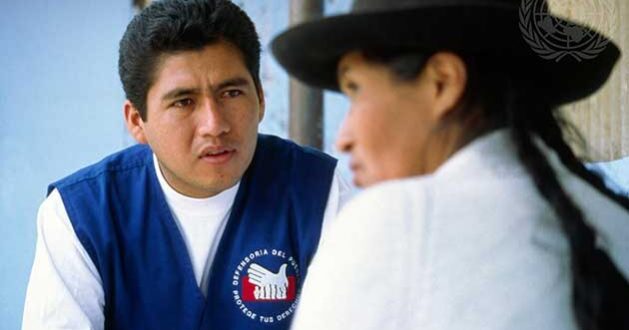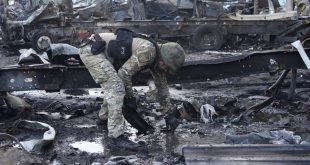NEW YORK, Jan 15 (IPS) – Whereas the world is grappling with the third wave of the COVID-19 pandemic, Peru continues to be coping with an epidemic that it has not been in a position to management—the mosquito-borne viral illness generally known as dengue.
With nearly 56,400 confirmed instances as of December, Peru is struggling the worst dengue epidemic since 2017, when the virus contaminated over 68,000 folks. The sickness, coupled with the novel coronavirus disaster, has left hundreds of individuals uncovered to malnutrition and water-borne illnesses.
Though mortality charges are low for dengue instances, nutritious diets and fast sanitary responses are wanted to battle the situation. And, above all, prevention is essential to dealing with future epidemics, provided that the mosquito chargeable for dengue, Aedes aegypti, is increasing to new territories in Peru. As casual settlements and urbanization enhance, so do Aedes larvae, which develop in stagnant water amassed in cans or pots.
“Dengue has develop into endemic to many areas in Peru whereas earlier than it was principally discovered within the tropical ecosystem areas,” says a researcher for the Pan American Well being Group (PAHO) in Washington DC, pointing on the areas of Madre de Dios, Loreto, Ucayali, and San Martin, amongst others. “It is regular to search out dengue close to the Amazon, however now we will discover it in desert-type areas. It must be simpler to manage dengue, nevertheless it’s troublesome to manage urbanization.”
The epidemic
The Peru dengue disaster started in October of 2019 when the instances elevated within the Madre de Dios area within the nation’s southeast. The federal government quickly despatched the armed forces to fumigate folks’s homes and kill the larvae whereas issuing suggestions to keep away from the virus.
Consequently, the unfold of the virus slowed down in November, with the Minister of Well being Elizabeth Hinostroza saying that dengue instances in Madre de Dios had decreased by 30%, as reported by local outlets.
However the respite was short-lived. In February, the federal government declared dengue a well being emergency, ramping up the sources devoted to combating off the virus. By the point the coronavirus pandemic hit Peru, dengue had unfold to 17 areas, together with Junin and Ica.
Nonetheless, the nation lacked the sources to face a pandemic and an epidemic concurrently.
Protests broke out in early March within the area of Loreto, northeast Peru, as a consequence of a scarcity of medical consideration to these contaminated. With air-borne COVID-19 assailing the nation and necessary lockdowns in place, fumigations grew to become troublesome if not not possible to conduct. Apart from, a few of the coronavirus signs, like complications, have been much like these generated by dengue.
In October of 2020, Peru raised the alarm again by “reinforcing the sanitary response to dengue’s management and prevention .” By the tip of the yr, the COVID-19 pandemic had left nearly 38,400 casualties, excessive unemployment ranges, and a rising casual economic system. (The underground economic system might have elevated from 70% to 80% or 90% because the pandemic hit Peru, say local outlets.)
Within the background, dengue stored spreading.
On December 9, The Nationwide Heart of Epidemiology, Prevention, and Illness Management, tied to the Ministry of Well being, despatched out an alert, warning that Peru was the third nation within the Americas area with the best mortality charge as a consequence of dengue. The Dominican Republic and Venezuela got here in first.
However what does dengue do?
Dengue is a mosquito-borne viral illness, widespread by the tropics as it’s “influenced by rainfall, temperature, relative humidity, and unplanned speedy urbanization,” explains the World Well being Group (WHO). The species Aedes aegypti can be the vector for different viruses resembling chikungunya, yellow fever, and Zika.
As local weather adjustments and urbanization will increase, the mosquito is discovering new locations to hatch. “If new areas get hotter, the vector Aedes will develop,” explains the PAHO researcher to IPS. “We are able to now discover it in greater altitudes than earlier than.”
The implications of the illness fluctuate, notes the WHO in a word on June 23, 2020. The signs might vary from these much like the flu to “extreme bleedings, organ impairment and/or plasma leakage.” In both case, the virus may also have an effect on ladies and anemics disproportionately.
“Dengue impacts on a person’s iron ranges, which will be particularly essential for pregnant ladies,” says Angel Muñoz, local weather variability researcher on the Worldwide Analysis Institute, which is a part of the Earth Institute at Columbia College. “Anemics usually tend to get the illness.”
Malnutrition
Dengue sufferers normally expertise excessive ranges of dehydration and lack of vitamins, so the consumption of water and vitamins is important.
Beneficial diets are wealthy in greens with vitamin A, C, and Ok, resembling spinach and beetroot, fruits with the latter two nutritional vitamins, resembling citrus, and nuts with proteins.
Nonetheless, in Peru entry to wash water will be tough in sure areas and marginal areas, the place stagnant water abounds. For example, within the area of Loreto, solely 45.four% of the inhabitants consumed consuming water by the general public infrastructure in 2019, notes the nation’s Nationwide Institute of Statistics and Informatics (INEI) in a 2020 report.
This lack of entry to consuming water heightens the affect of dengue and ends in different malnutrition issues. The Food Sustainability Index, developed by the Barilla Center for Food & Nutrition and the Economist Intelligence Unit, notes “poor sanitation and a scarcity of fresh water contribute to malnutrition ensuing from diarrhea.” In distinction, the index says that “improved sanitation and higher water companies additionally assist sort out world starvation.”
On high of those infrastructural issues, the Meals and Agriculture Group (FAO) warns in its latest report that malnutrition elevated in 2020 as a result of COVID-19 pandemic, deepening the pervasiveness of dengue. “Over the past 5 years, the scenario has worsened with a rise of 13.2 million folks with undernutrition,” says the FAO.
Find out how to forestall dengue
Prevention is important to manage dengue, each by forecasts and consciousness campaigns performed by public establishments.
Analysis has proven a relationship between local weather patterns and the mosquito’s life cycle, as defined within the paperAeDES: a next-generation monitoring and forecasting system for environmental suitability of Aedes-borne illness transmission, authored by Muñoz and different researchers.
“There is a relationship between environmental circumstances resembling temperature, rainfall and humidity, and the mosquito’s life cycle,” he explains to IPS. “It’s doable to do dependable local weather forecasts and predict the chance of the illness spreading.”
On account of the paper, the group at IRI has designed a tool to observe and forecast Aedes-borne environmental suitability, which may very well be utilized by policymakers to foretell the potential affect of dengue.
Nonetheless, predicting dengue’s likelihood isn’t sufficient, as the knowledge should attain the inhabitants. Muñoz notes that consciousness campaigns are important to making sure the general public is aware of how the illness spreads. “Recipients with stagnant water or massive landfills create the right habitat for the mosquito.”
By means of the Ministry of Well being, the Peruvian authorities has launched consciousness campaigns up to now, its newest being “Dengue kills. Kill the mosquito!”
This campaign emphasised eliminating breeding grounds for the species, each by preventive measures and fumigation. A few of its suggestions embody:
- “In case you have flowerpots or aquatic crops, clear the recipients each two days .” day-after-day you water the crops.”
- “Tightly shut the recipients the place you retailer water .”
However fumigations and consciousness campaigns require huge quantities of sources. Whereas the areas have unique budgets to struggle mosquito-borne illnesses, up to now months a portion of that cash has been used to face the pandemic, report Jorge Carrillo and Alicia Tovar for Peru’s investigative outlet Ojo Público.
Consequently, populations with much less entry to data, healthcare, and decrease socioeconomic circumstances stay extra in danger as a result of they’re extra more likely to protect cans or planters to preserve water.
“We’d like instruments to know the affect of environmental elements on dengue’s seasonality. If we have now an in depth system of who may very well be extra in danger and the place and when dengue may unfold, we may reinforce prevention methods,” concludes Muñoz.
Follow @IPSNewsUNBureau
Follow IPS New UN Bureau on Instagram
© Inter Press Service (2021) — All Rights ReservedOriginal source: Inter Press Service
 Top Naija News – Nigeria News, Nigerian News & Top Stories Top Naija News – Nigerian Newspapers, Nigerian News. topnaijanews is a daily Nigerian newspaper covering Latest News, Breaking News, Entertainment, Sports, Lifestyle and Politics.
Top Naija News – Nigeria News, Nigerian News & Top Stories Top Naija News – Nigerian Newspapers, Nigerian News. topnaijanews is a daily Nigerian newspaper covering Latest News, Breaking News, Entertainment, Sports, Lifestyle and Politics.




